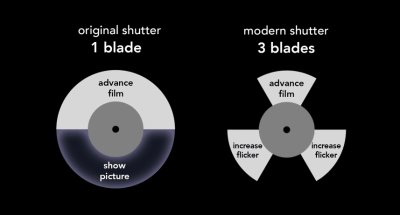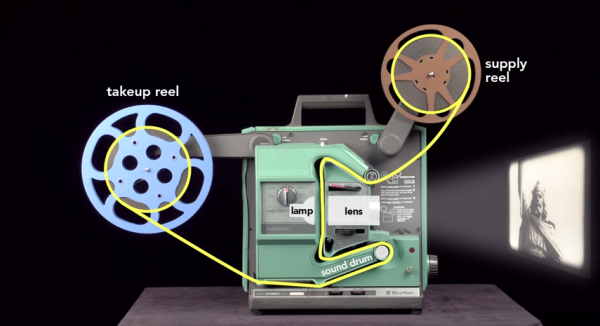Do you know how a film projector works? We thought we did, but [Bill Hammack] made us think twice. We have covered the Engineer Guy’s incredibly informative videos many times in the past, and for good reason. He not only has a knack for clear explanation, the dulcet tones of his delivery are hypnotically soothing. In [Bill]’s latest video, he tears down a 1979 Bell & Howell 16mm projector to probe its inner workings.
Movies operate on the persistence of vision (POV) principle, which basically states that the human brain creates the illusion of motion from still images. If you’ve ever drawn circles and figure eights in the nighttime air with a sparkler or perused a flip book, then you’ve experimented with POV.
A film projector is no different in theory. Still images on a strip of celluloid are passed between a lamp and a lens, which project the images on to a screen. A device called a shuttle advances the film by engaging its teeth into the holes on the edge of the film and moving downward, pulling the film with it. The shuttle then disengages its teeth and moves up and forward, starting the process again.
 Film is projected at a rate of 24 frames per second, which is sufficient to create the POV illusion. A projector’s shutter inserts itself between the lamp and the lens, blocking the light to prevent projection of the film’s physical movement. But these short periods of darkness, or flicker, present a problem. Originally, shutters were made in the shape of a semi-circle, so they block the light half of the time. Someone figured out that increasing the flicker rate to 60-70 times per second would have the effect of constant brightness. And so the modern shutter has three blades: one blocks projection of the film’s movement, and the other two simply increase flicker.
Film is projected at a rate of 24 frames per second, which is sufficient to create the POV illusion. A projector’s shutter inserts itself between the lamp and the lens, blocking the light to prevent projection of the film’s physical movement. But these short periods of darkness, or flicker, present a problem. Originally, shutters were made in the shape of a semi-circle, so they block the light half of the time. Someone figured out that increasing the flicker rate to 60-70 times per second would have the effect of constant brightness. And so the modern shutter has three blades: one blocks projection of the film’s movement, and the other two simply increase flicker.
[Bill] explains how the projector reads the optical soundtrack. He also delves into the mechanisms that allow continuous sound playback alongside intermittent projection of the image frames. You’ll never look at a projector the same way again.
Want to know more about optical soundtracks? Check out this Retrotechtacular that explores the subject in detail.
Continue reading “Shedding Light On The Mechanics Of Film Projection” →



 Film is projected at a rate of 24 frames per second, which is sufficient to create the POV illusion. A projector’s shutter inserts itself between the lamp and the lens, blocking the light to prevent projection of the film’s physical movement. But these short periods of darkness, or flicker, present a problem. Originally, shutters were made in the shape of a semi-circle, so they block the light half of the time. Someone figured out that increasing the flicker rate to 60-70 times per second would have the effect of constant brightness. And so the modern shutter has three blades: one blocks projection of the film’s movement, and the other two simply increase flicker.
Film is projected at a rate of 24 frames per second, which is sufficient to create the POV illusion. A projector’s shutter inserts itself between the lamp and the lens, blocking the light to prevent projection of the film’s physical movement. But these short periods of darkness, or flicker, present a problem. Originally, shutters were made in the shape of a semi-circle, so they block the light half of the time. Someone figured out that increasing the flicker rate to 60-70 times per second would have the effect of constant brightness. And so the modern shutter has three blades: one blocks projection of the film’s movement, and the other two simply increase flicker.









